Rural schools in Malaga: when all the village children are in the same class
Children of ages from three to eleven study side by side with the same teacher although they are taught according to their level. They share their Music, English and PE teachers with other schools in nearby villages. The smallest schools in Malaga province stand steadfast against depopulation with every new term
Rossel Aparicio / Enrique Miranda
Miércoles, 15 de marzo 2023
8.55am marks the start of the school day in Sayalonga only birdsong and a few children's voices break the silence. There is no hustle and bustle, no shouting, no horns, no cars double-parked and no crowds of parents waving their children off. The children arrive on foot, most of them alone, apart from the youngest pupils who are accompanied by a parent or guardian. They say hello to the visitor at the door whose face is unfamiliar to them. The peace is a stark contrast to an inner city school.
Almijara primary school has its main centre in this Axarquía village, although it also has other centres in the area via a network of classrooms located in Corumbela (a hamlet belonging to Sayalonga), Árchez, Salares, Sedella and Canillas de Albaida. The network has a total of 169 pupils and 25 teachers; seven of whom are temporary, and is one of the 12 rural public schools currently in the province of Malaga in which around 1,200 children are taught. It is a teaching model that covers the smallest municipalities and differs from the usual system in terms of the small number of pupils and the multi-year classrooms, with students of different ages in the same class as well as the fact that some subject teachers travel between the schools to give specific classes, such as PE, English and Music.
Nine pupils for one teacher

In Salares, a small village with steep streets and a population of just 175 inhabitants, nine children attend the local school. They are friends, neighbours, some relatives and, of course classmates, although their ages range from three-year-old Simón, to Samuel who at 11 is the oldest child at the school. "Here we are all mixed together, it is a single classroom: I have four children in Infants and five in Primary. In other words, six different levels in the same class", class teacher Estefanía Bandera explains to SUR. In her class the only separation are the tables; one for the infants and one for the primary children. So, while one pupil is doing maths, another is playing with plasticine. "
At the beginning it was a bit, oh my goodness, where am I? The first month was very intense. But then we got going, [the children] got used to me and I got used to them," explains the teacher, who has been at the school since September.
Bandera drives about an hour every day from Malaga city to work at the school in the heart of the Sierras de Tejeda, Almijara and Alhama Natural Park.The rural school building is small, but there is still plenty of space for the nine students. A second classroom is only used when the other subject teachers come and they have heating, good internet connection and a digital whiteboard - just the same as any city school. At the moment they do lack space in the playground, as they only have a small patio to play on - albeit with excellent views of the mountains - a situation that will change when work to the sports courts that are being built next to the school is complete; something the pupils are looking forward to.
Organisation in these unified classrooms is vital. The teacher writes the tasks for each class on the board so that the pupils can visualise what they have to do. "I explain to each one what they have to do each day and they start working on their own. I do have to sit down more with the infants once the older ones have started to work," says Estefanía.
Another key factor is the good relationship among the pupils: "It's not easy and I tell them that they have to get along, but they are like a small, well-adjusted family, with the older ones taking care of the younger ones and even accompanying them to the toilet,” reflects the teacher, who also highlights the good relationship with the families.
There are downsides to being at such a small school, like socialisation problems and children being the only one in their year and not having peers the same age as them. On the other hand, the teaching is personalised and it’s almost like having private classes: "They even learn from others" Bandera points out.
Separated into two classes

At the school in Corumbela, one of the highest villages in the Axarquía, there are 16 children and they have a classroom for the seven infants and a separate one for the nine primary children. María and Carmen are the two teachers at the school, which is accessed by a small lane where cars sometimes have to stop to allow herds of goats to pass.
The infants (three to six-years-old) share a classroom and everyone from six to 11 is together. "You have to take into account that there are very few of them and that they are siblings, cousins, neighbours. They take care of each other and protect each other a lot," says Carmen Romero, the infant school teacher, who has a lot of experience in rural schools.
In fact, she is from Canillas de Albaida, where she was also in the same classroom as other years. "The reality of villages and rural schools has changed a lot," explains Romero. "In addition to technology, now children don't have the feeling of isolation they used to have, families have evolved, they go out much more, they travel and see other places. Before, it was much more closed," she recalls.
"Here we have everything," says Romero’s colleague María Jurado. "The surroundings are beautiful, the relationship with the families is very good and the teaching is individualised. The problem is that there are few children; they can only interact with each other and it is complicated to do group activities, especially when there is only one pupil per school year.”
The children say they are happy and don't miss more company. And the parents are happy that they can send their children to a school that is close to home. "They are the only children in the village and they are together from the moment they start to the moment they leave. The most important thing for us is that they don't close it, that they can study here", says Andrea Lopera, who as well as being a mother of pupils was once a pupil at the school. "I think they learn more this way, because in a big school they can't pay as much attention to each child," says another mother, who also highlights the advantage that if she can't pick up the children from school there is always a neighbour or a relative from the village who will take care of them.
"You become an expert in the classroom and at the wheel"

A fundamental part of the rural schools’ education are the teachers who come to teach specific subjects (Physical Education, Music, Religion, English...) in the different villages. "It's a bit different from what we are used to in city schools. Every day we go from one place to another and we have some free time in our timetable for travelling," explains Pablo Madrid, a PE teacher. He says that having few pupils makes classes easier, although it also has its disadvantages: "It is more difficult to play games or do group activities, so we bring together children to have at least 20 pupils.” They also use the municipal sports facilities for the lessons. For Music teacher Beatriz Barranquero this way of teaching “has a special charm”. She says that despite the travelling - she teaches music at all six of the school’s centres – it’s all worth it. "I recommend this experience. You have a closer relationship. The schools and children are already part of me", she says.
A barrier against depopulation
Rural schools have a fundamental role to play against the depopulation of small villages. A village without children has little future and, for this reason, the closure of a classroom in certain areas can be catastrophic for the area. Antonio Rueda, the head teacher at the Almijara primary school, has a sheet of paper hanging in his office with the number of pupils he has in each of the its centres and fears that for the next academic year he may be down to just one classroom in places where there are currently two.
"Here, we have never had to consider factors like postcode or other siblings in the school, everyone who wanted to enrol can do so," he explains. Rueda knows all about the challenges faced by rural schools and the rules and regulations set by the authorities, but he also sings their virtues: "These types of villages and schools are perfect for families who telework. They offer low rent, subsidies and grants, almost individualised teaching and, in addition, children can play outdoors and without the problems of the big cities," he concludes.
¿Tienes una suscripción? Inicia sesión


